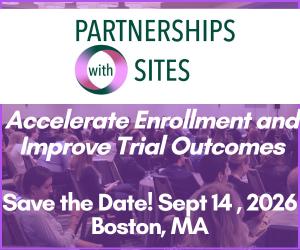Archive Highlight: How BMS Builds Trial Matching into Their Clinical Workflow
Gaelan Ritter discusses how BMS is leveraging real world data and predictive analytics to identify patients for clinical trials with more lead time for engagement. Mr Ritter, MS, MBA, is Head of Analytics Innovation and Digital Health at Bristol Myers Squibb.

Can you speak about the work you are leading?
We are working with several of our real world data companies and clinical systems companies to build clinical trial matching capabilities where the study design and inclusion/exclusion criteria from the BMS trials are being leveraged through algorithms against the EMR systems at those sites so that the sites get real-time visibility into trials that patients might qualify for.
In the past, that type of activity was very manual. They would have to manually review the trial design and comb through patient records whether digital on the EMr or paper records to identify the patients that fit the trial. The new way is that if a patient meets the criteria, the record is flagged right in the EMR at the time that the patient’s data qualifies them for the study. The treating physician, PI, and CRC all have real-time access to know that a patient came through and fits our trial design so that they can take immediate action, review the charts together and decide if the patient fits for the trial.
Has there been any feedback from the sites or any reported improvements in patient engagement based on using these algorithms/ technologies?
When we first started running these projects 4-5 years ago, the algorithms were very poor at identifying the patients that really fit the trials so you had a lot of false positives. That would add work for the sites. We have spent a lot of time refining those algorithms, refining the access models for the EMRs and building better digital protocols so that companies have more access to what our protocols really are and leverage them in the EMRs.
It was really about refining all of those integrations points so that now when we flag a patient as eligible for a study or give a site a list of the patients who qualify, we are much more confident in that list and it is much more reliable and more accurately curated so that it is a true representation of what they can expect.
What has the improvement been since undertaking this work?
We had a 98-99% false positive rate when we first started this a few years ago. Now we’re down to a 30% false positive rate which is a significant improvement. Now we are at the place where it is actually reducing the time and effort on the sites. When we first started the pilots it very much was a joint work in progress because there was a lot of effort that went into refinement.
The other feedback we’re getting is that it is super important for sites that this becomes part of their native workflows. For treating physicians who may not necessarily be part of the trial, it can’t be a separate tool, platform or dashboard that they get because they wouldn’t be familiar with that and it would mean training every staff member on the site, which doesn’t make logistical sense.
We built it to look like a native part of the EMR or CTMS and that way, those treating physicians or others at the site can understand and action some of the information they receive and then when they contact the PI or CRC, that group is much more familiar with trial standards and actions taken to enroll patients on a trial. The treating physicians who may be trial naive or aren’t classically involved in trials can still get patients access to trials without having to learn the whole process themselves. It’s a really nice balance to let the experts of the site take the ball when the treating physicians see that there is an opportunity.
How can we better integrate clinical trial matching into the clinical workflow?
In terms of doing it better than we are today, making it more accurate is critically important. Also, the predictive nature of it. Right now, it is based on actuals which can leave you with an incredibly short treatment window for certain diseases. You want to spend a very limited amount of time deciding on treatment pathways for a patient. Maybe an experimental product would be appealing but you only have 72-96 hours to make that decision and getting the information about the trial takes too long so it isn’t worth it from that perspective.
Giving as much information to the sites when the flag occurs so the treating physicians can get the information they need about the trial to understand if it is a real alternative therapy option for this patient or is this not something I want for this patient.
What have you incorporated in terms of patient burden?
We want the patient to understand what it means to be part of the trial and the time it might take. Patients don’t necessarily have the time to read through all the protocol information and dive in deep with clinical research coordinators or PIs when their schedule allows. What does this trial mean for the patient and should they consider it or not based on their life schedule. Making it as robust as possible from when a patient is identified as a match to get that information across, but then also to provide that predictive nature so we can say, “The patient is at a certain place in their healthcare journey and there is a 75% likelihood that a patient like that may match a trial like this in the next 6 months, so based on how the treatment goes, this could be a next course of care.”
If it’s a third-line trial, patients in the second line who look like they may fit that trial in the future can start getting information about it and other considerations so that if they do progress to that later line of therapy they are already aware of their treatment options there. Oncologists are really good about having those discussions early but they seldom include clinical trials in that conversation. We’re trying to position so physicians can have these conversations earlier in the pathway so that they don’t have to delay treatment if they feel that the experimental treatment of the trial is the right course for the patient.
"We don’t want patients to have to wait to become part of a trial. If the trial fits where they are in their healthcare journey, we need to make it an option for them as soon as possible."
What is the sponsor’s role with just-in-time startup?
The goal with these sites is that when the patient is identified, BMS can activate and enroll that patient in less than two weeks. We don’t want patients to have to wait to become part of a trial. If the trial fits where they are in their healthcare journey, we need to make it an option for them as soon as possible. Any delay is not good. In life threatening conditions it’s a safety risk but even with other conditions it isn’t acceptable for there to be delays and waiting to enroll in a trial. We’re trying to streamline that process as much as possible from when the patient is identified and interested in a trial, getting them the information and then starting to get that site set up to run the trial if they aren’t running it already to get the pull through as quickly as possible for the patient.
What do you think clinical trial matching will look like in the next 3-5 years?
I hope it looks like an end-to-end workflow. Very much in the personalized medicine direction, as the patient moves through their healthcare journey, their treating physicians -- whether at academic medical centers or community hospitals and clinics -- see which types of trials might fit for the next stage of the patient’s journey based on how they progress.
As the patient progresses, the tactics and information about what the trial contains and why the patient is a good fit is presented to the physician. Is it because of the patient’s safety profile or because of other characteristics of the study? This way the physician knows why this is a reasonable study and course of care for this patient.
Providing information about the assets of the study design, previous study readouts in that flow and then working that information into the native pipeline for them so that as they’re treating the patient they move through their treatment options. If they decide to try the experimental drugs on the trial as a treatment, the information comes to them and the patient. They can understand what they are participating in and what they’re considering. They can work through it with the rest of the people at their site. Dashboarding it so they can talk about the same patient cohesively. Then making it as seamless for the site to pull that patient through the steps of enrollment like prescreening and screening. All along the way, having the feedback loop. So if patients fall out after prescreenings due to technology or analytical reasons, we go back and address those things.
In 3-5 years, it would be creating that integrated workflow, making it low burden and seamless for the patients and treating physicians, and then instantiating that as much as possible in the US and expanding outside the US.
"We’re trying to point these companies to the sites we would like to run trials for us rather than just the sites that have RWD value for them because I do think getting more of those sites on that integrated technology backbone will be most important."
What steps do we need to take, especially outside of the major networks and hospitals?
Outside of the major networks and hospitals, I think it is really important to get those EMRs on the backbone of these RWD companies’ systems so that they have the integrations built and can do some of this work. Today, one of the problems is that those sites are considered low value for the RWD space because they don’t have a large number of patients, which is unfortunate. We’re trying to point these companies to the sites we would like to run trials for us rather than just the sites that have RWD value for them because I do think getting more of those sites on that integrated technology backbone will be most important. It is then about working with the sites to integrate this into their workflows but that actually becomes pretty simple.
There are only a handful of EMRs out there and everyone is using one of them. It’s a matter of getting those systems integrated and training sites and getting them comfortable with the tooling but that ends up being pretty standard. Then it’s about educating treating physicians about what this means for the way they approach clinical care and how this provides clinical decision support for them and how they should look at them. Trials aren’t the right option for every patient. They aren’t even the right option for every patient who matches the I/E criteria for a trial. How do we provide them the information they need to make that decision without needing to read 150-page documents.
For more information on CRAACO: Clinical Research as a Care Option, visit CRAACOevent.com.






